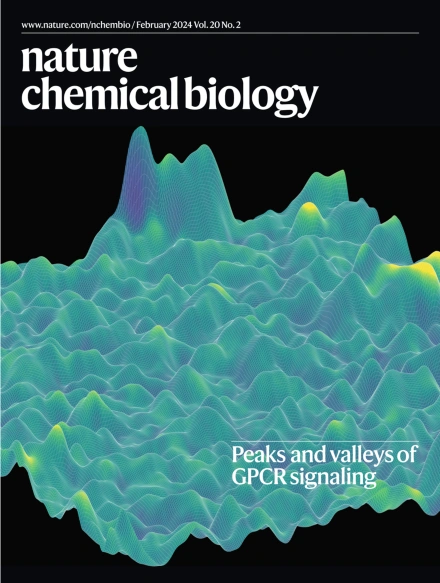一种小分子靶向LIC1,通过诱导自噬抑制肺肿瘤生长。
IF 13.7
1区 生物学
Q1 BIOCHEMISTRY & MOLECULAR BIOLOGY
引用次数: 0
摘要
在特定的生物环境中诱导自噬的小分子可以提供宝贵的化学探针和潜在的抗癌治疗方法。在这里,我们从内生菌衍生的小分子文库中鉴定了一种有效的自噬诱导剂auxarthrol a (DAA)的3,4-二异丁基衍生物。DAA在非小细胞肺癌(NSCLC)肿瘤中显示出显著的抗肿瘤疗效,并使肿瘤对抗pd1免疫治疗增敏。利用光亲和标记方法,我们发现动力蛋白的一个亚基——光中间链1 (LIC1)是DAA的直接靶标。我们发现LIC1在NSCLC肿瘤中过表达,并与低生存率相关。机制上,DAA靶向LIC1可显著破坏LIC1与应激感应效应物ruvb样AAA atp酶1之间的相互作用,进而提升下游GCN2-eIF2α-ATF4轴介导的综合应激反应,最终促进细胞自噬死亡。我们的研究结果将LIC1定义为非小细胞肺癌的一种新的治疗靶点,并强调了DAA作为一种有希望的自噬诱导剂治疗这种疾病的潜力。本文章由计算机程序翻译,如有差异,请以英文原文为准。
A small molecule targets LIC1 to suppress lung tumor growth by inducing autophagy.
Small molecules that induce autophagy in specific biological contexts can provide invaluable chemical probes and potential anticancer therapeutics. Here we identified a potent autophagy inducer 3,4-diisobutyryl derivative of auxarthrol A (DAA) from an endophyte-derived small-molecule library. DAA demonstrates notable antitumor efficacy in non-small cell lung cancer (NSCLC) tumor and sensitizes tumors to anti-PD1 immunotherapy. Using a photoaffinity labeling approach, we identified light intermediate chain 1 (LIC1), a subunit of dynein, as the direct target of DAA. We found that LIC1 is overexpressed in NSCLC tumors and correlates with poor survival. Mechanistically, the targeting of LIC1 by DAA markedly disrupts the interactions between LIC1 and stress-sensing effector RuvB-like AAA ATPase 1, which in turn elevates downstream GCN2-eIF2α-ATF4 axis-mediated integrated stress response, ultimately promoting autophagic cell death. Our findings define LIC1 as a novel therapeutic target for NSCLC and highlight the potential of DAA as a promising autophagy inducer for treatment of this disease.
求助全文
通过发布文献求助,成功后即可免费获取论文全文。
去求助
来源期刊

Nature chemical biology
生物-生化与分子生物学
CiteScore
23.90
自引率
1.40%
发文量
238
审稿时长
12 months
期刊介绍:
Nature Chemical Biology stands as an esteemed international monthly journal, offering a prominent platform for the chemical biology community to showcase top-tier original research and commentary. Operating at the crossroads of chemistry, biology, and related disciplines, chemical biology utilizes scientific ideas and approaches to comprehend and manipulate biological systems with molecular precision.
The journal embraces contributions from the growing community of chemical biologists, encompassing insights from chemists applying principles and tools to biological inquiries and biologists striving to comprehend and control molecular-level biological processes. We prioritize studies unveiling significant conceptual or practical advancements in areas where chemistry and biology intersect, emphasizing basic research, especially those reporting novel chemical or biological tools and offering profound molecular-level insights into underlying biological mechanisms.
Nature Chemical Biology also welcomes manuscripts describing applied molecular studies at the chemistry-biology interface due to the broad utility of chemical biology approaches in manipulating or engineering biological systems. Irrespective of scientific focus, we actively seek submissions that creatively blend chemistry and biology, particularly those providing substantial conceptual or methodological breakthroughs with the potential to open innovative research avenues. The journal maintains a robust and impartial review process, emphasizing thorough chemical and biological characterization.
 求助内容:
求助内容: 应助结果提醒方式:
应助结果提醒方式:


